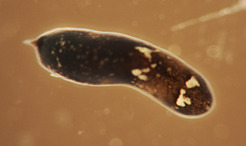Scientists reorganise the animal phylogenetic tree
18 Feb 2011
The genus Xenoturbella lives off the coast of Scandinavia, Scotland and Iceland. It shares a simple body structure with the acoelomorph worms: these organisms, which reach a maximum size of just a few millimetres, have no through gut, no gill slits and no body cavity (Greek: coelom = cavity). Many members of both groups live on the ocean floor and feed on organic particles in the sediment. Some species live parasitic, e.g. in the intestines of sea cucumbers.
 |
| Modified phylogeny: The Xenacoelomorpha represent the fourth phylum of the deuterostomia. © Art for Science |
The animal kingdom is divided into different evolutionary lines. These include, among others, the protostomes (''mouth first'') and deuterostomes (''second mouth''). In the protostomes, the mouth that develops at the beginning of embryonic development becomes the organism's actual mouth, whereas, in the deuterostomes, it becomes the anus and the mouth develops at a later stage. Three deuterostome phyla were known up to now: the Chordates (e.g. vertebrates), the Echinoderms (sea urchins, starfish, sea cucumbers) and the Hemichordates (e.g. acorn worm). ''Our research shows that Xenoturbellida and Acoelomorpha together form the fourth phylum which we have called 'Xenacoelomorpha','' explains Albert Poustka from the Planck Institute for Molecular Genetics in Berlin.
 |
| Worms of the genus Xenoturbella belong to another deuterostome branch. © University of Tsukuba, Japan/Hiroaki Nakano |
With the help of extremely processor-intensive mathematical models, the scientists examined new ''mini'' genes (microRNAs) and amino acids from the fully sequenced mitochondrial genomes of Acoelomorpha and Xenoturbellida, and a large set of several hundred genes. The analysis of the Xenoturbella microRNAs and the acoelomate worm Hofstenia miamia showed that the previously analysed acoelomate worm Symsagittifera roscoffensis had lost many of these ''mini'' genes. The gene repertoire of the analysed animals points instead to the kinship between these animals and the deuterostomes. For example, they have a microRNA that was previously only known to exist in echinoderms and acorn worms. Moreover, all of the animals analysed up to now from the new Xenacoelomorpha phylum have the gene RSB66, which could previously only be demonstrated in deuterostomes.
 |
| Hofstenia miamia also belongs to the deuterostomes. © Uppsala University/Andreas Wallberg |


.webp)




























